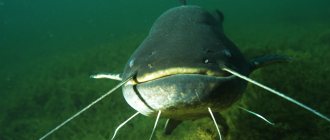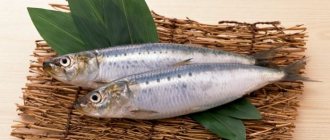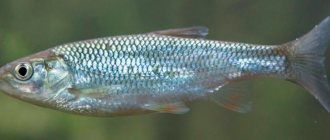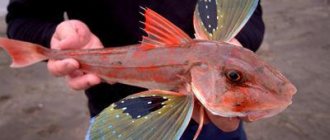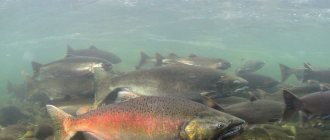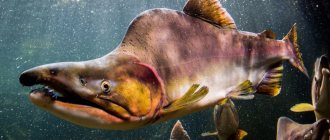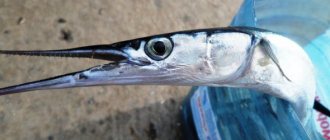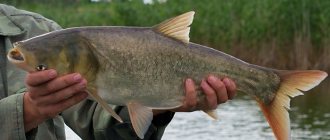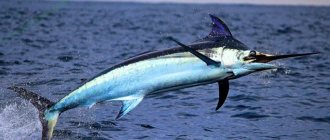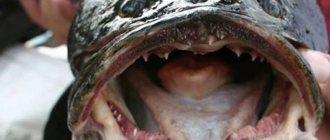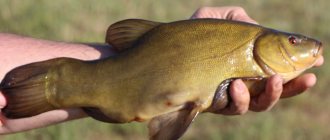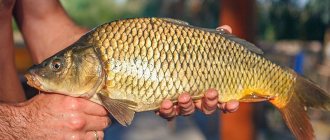- Habitat
- Family
- Appearance
- Taste and color
- Bony or not
- Fat or not
- How is it different from other fish?
- Useful properties For women
- For children
Haddock is a representative of low-fat fish.
Despite its rich chemical composition, it contains few calories. This quality makes it attractive to everyone: men and women, adults and children, young and old, people on a strict diet and food lovers. It is a game fish of commercial importance due to its high demand in the produce market. It can always be found on store shelves, because it ends up in fishermen’s nets at any time of the year.
For the consumer, this is an excellent food product in fresh, frozen, salted, smoked and dried forms.
A book of recipes for dietary fish dishes would take more than one page.
Habitat
Haddock is found only in salt water. More often it can be found in the waters of the Atlantic and Arctic oceans. On the territory of Russia - in the Barents and White Seas. This is a commercial fish: catching is carried out in Murmansk and on the Kola Peninsula.
A comfortable environment for it is the bottom of the sea with a water temperature of + 6°C. It prefers a depth of about 60 meters, although it can go deeper – up to 200 and even 500 meters. Adults who have reached two or three years of age decide to visit the deepest places. Therefore, they catch it in deep places during high tide. During the cold season, you can catch it closer to the shore.
Although the fish is not large, it is a predator and feeds on the fry of other fish, eggs and various invertebrates. The juveniles eat zooplankton, but grow quite quickly, and soon their menu begins to include small fish, young eels and even squid. It is characterized by feeding migration.
Fishermen have the concept of “Black Sea haddock” - found on the shores of Crimea and the southern regions of our country. It also belongs to the cod family, but its scientific name is whiting. The two types of fish are very similar not only in appearance, but also in taste. A significant difference in size is that the southern representatives are slightly smaller in size.
Haddock
How they catch
Haddock is a valuable commercial fishery object. They hunt for it using all kinds of trawls, longlines, and gill nets. Today, after pollock and cod, it ranks third in terms of the number of fish caught. Very popular among UK residents.
For reference! Recently, haddock fishing has been reduced due to a decrease in its population.
Massive commercial fishing for haddock has led to a reduction in its numbers
Recreational fishing for haddock is also possible. Fish are caught vertically from boats and boats. For this, natural baits are used, such as frozen shrimp, fresh small fish, shellfish, and pieces of squid. Artificial spoons are rarely used because they are less effective than the listed baits.
Family
In the discussion, is it a sea fish or a river fish, the answer is one - sea fish, and it spawns and lives in salty waters. Both Atlantic and Black Sea haddock belong to the cod family. The average age in the wild is 10 years. Sexual maturation occurs at 2-4 years. Large females are capable of laying up to 3 million eggs. They migrate with the ocean current. The hatched fry live almost on the surface of the water. As they grow, they sink closer to the bottom. This cod fish leads a schooling lifestyle, moving in space in large groups.
Reproduction
This cod representative of the ichthyofauna reaches sexual maturity in the third to fifth year of life, when its weight reaches about one kilogram and its body length is 40 cm. Depending on the living conditions and food supply, this can happen earlier or slightly later.
Pollock fish: recipes
Haddock spawning occurs from early April to June. Spawning is preceded by fish migration, which begins 5–6 months before. Schools of this cod move to the shores of Norway, Iceland and Scotland, off New England, and along the coast of Canada near Nova Scotia.
Haddock spawns at decent depths, from 120 to 150 meters. The fertility of females directly depends on their age and size. The most productive individuals can spawn up to 3 million spherical eggs with a diameter of about 1.5 mm. The eggs are pelagic and are carried over a large area by currents.
The period of ripening of eggs lasts from two weeks to a month and directly depends on the water temperature. The emerging juvenile haddock spends the first months of its life near the surface of the water, where it hides from the enemies of the waters with the domes of jellyfish. Having gained a little weight, the fish gradually descends to depth.
Appearance
When you pick up a fish, it is not easy to determine whether it is an Atlantic haddock or a Black Sea one. They are very similar except for minor differences.
Atlantic fish are large. The length of her body reaches 70 centimeters. Weight – 2-3 kilograms. The Black Sea whiting is smaller - only 25-30 centimeters in length, with a body weight of up to 500 grams.
The appearance is similar in the following ways:
- the body is tall, slightly flattened;
- the back is gray or brownish with a purple tint;
- sides silvery;
- the belly is white or milky in color.
But the stripe along the entire body with a round dark spot is characteristic only of the northern fish. Both varieties have a small mouth with an overhanging upper jaw and non-sharp teeth. There are three fins on the back and two on the belly.
There are differences between Atlantic and Black Sea haddock
Taste and color
All cod, one way or another, are similar in terms of taste. We can say that haddock is similar in taste to cod. But there are also differences.
Haddock meat is white and very tender. It can be confidently called dietary.
Even the fat that an individual accumulates while swimming freely is collected to a greater extent in its liver. The taste and smell are pleasant, there are no coarse fibers. Easily amenable to heat treatment. Housewives boil it, fry it, bake it, and stew it. Select various side dishes.
Haddock tastes like cod
Bony or not
Haddock contains practically no bones, yet the latter are easily crushed and crumble even at the stage of heat treatment. Such properties allow you to prepare a wide variety of dishes, which makes haddock a very versatile product. It can be used to make soups; it does not lose its taste when smoked.
You can make delicious cutlets from the breast, and the low bone content and their low strength allow you to use haddock to prepare the most delicate pates.
How does haddock differ from other fish?
| Fish | Taste | Fat content (per 100g product) | Nutrients (per 100g of product) / % daily value | |||||
| Omega-3 | Phosphorus | Iron | Iodine | RR | D | |||
| Haddock | Soft, without foreign tastes. The meat is dense and flaky. | 0.6g | 0.14g / 15.6% | 180mg / 22.5% | 0.7 mg / 4% | 150mcg / 100% | 6mg / 30% | 0.5 µg / 5% |
| Pollock | Strong fishy taste and smell. | 0.9g | 0.2g / 23% | 240mg / 30% | 0.8 mg / 4.4% | 150mcg / 100% | 4.6 mg / 23% | 0.2 µg / 2% |
| Hake | The taste is neutral, the meat is dry. | 2.2g | 0.4g / 46% | 240mg / 30% | 0.7 mg / 4% | 160mcg / 107% | 4.3 mg / 22% | 1.5 µg / 15% |
| Cod | A very delicate, fishy smell is not very pronounced. | 0.6g | 0.17g / 18.5% | 210mg / 26% | 0.5 mg / 3% | 135mcg / 90% | 5.8 mg / 29% | 0.5 µg 5% |
| Saida | Does not have a pronounced smell or taste of fish. | 0.5g | 0.4g / 46% | 300mg / 37% | 0.8 mg / 4.4% | 150mcg / 100% | 3.3 mg / 16% | 1µg / 10% |
The comparison table shows that haddock is practically in no way inferior to other cod species. There is the least fat in it and in the side. Although the fat content is quite low, all types of fish are dietary. The index of Omega-3, polyunsaturated fatty acids is the highest in hake and pollock. But almost 16% of the daily value in haddock is high. Iodine is present in all types of fish, and one piece of 100 grams absolutely covers the daily requirement. This means that if you regularly include cod fish, including haddock, in your diet, you can protect yourself from thyroid diseases. This fish should attract people with hypertension and diabetes, as it is the record holder for the content of nicotinic acid (vitamin PP).
What is the difference between haddock meat and cod? It is not so easy to distinguish them, because in both representatives it is delicate, without a strong fishy smell. The difference is that haddock meat is denser and more flaky.
It’s hard to say which is better: haddock or hake, pollock or cod. Those who love the delicate taste of fish will choose pollack, cod and haddock. Lovers of classic fish taste will prefer pollock.
Fried haddock
Beneficial features
The composition of haddock is varied and healthy. There is iron, which prevents anemia, and iodine, without which the functioning of the thyroid gland is impossible. The list of body functions in which Omega-3 and Omega-6 are involved is striking in its diversity. They help prevent a number of problems:
- frequent viral and colds;
- rickets in children;
- disorders in mental development;
- weakened immunity;
- cardiovascular diseases;
- excess weight;
- anemia.
Healthy haddock meat will also help
- reduce bad cholesterol levels;
- activate mental processes;
- enrich the body with vitamin D;
- reduce the risk of diabetes, including type 2;
- protect from arthritis, sclerosis;
- maintain visual acuity.
Low-calorie protein has a beneficial effect on the functioning of the stomach and other gastrointestinal organs.
For women
This fish is simply necessary for the fair half of humanity.
It will help young women
- slow down the aging process;
- activate metabolism;
- get rid of excess weight;
- restore the condition of hair and nails;
- make teeth stronger;
If a woman is pregnant or has already given birth to a baby, fish from the cod family will help her endure pregnancy more easily and recover quickly in the postpartum period:
- has a beneficial effect on the development and health of the child;
- will compensate for iodine deficiency;
- will increase hemoglobin levels;
- reduce the effects of postpartum depression;
- restore health after childbirth;
- will help keep weight under control;
- will increase immunity.
Doctors recommend eating haddock and other sea fish 2-3 times a week.
It is worth remembering that when consuming you need to be sure that there are no allergies or individual intolerances in either the mother or the child.
For women in adulthood, this fish will help them more easily cope with the restructuring of the body:
- will normalize hormonal levels;
- strengthens nerves and overall well-being;
- normalizes blood pressure;
- improve visual acuity;
- will support the condition of the skin, nails and hair;
- will reduce the likelihood of arthritis and arthrosis;
- will protect you from heart attacks and strokes.
For children
For a child, fish is very important in the diet. Haddock as a dietary product in particular. Its meat, rich in nutrients, is involved in the formation of the skeletal system and teeth. Omega-3, vitamin D, iodine promote mental processes, the development of memory, attention, improve the functioning of the gastrointestinal tract, and maintain visual acuity. They also increase immunity and resistance to stressful situations.
Pediatricians recommend starting to introduce haddock into the diet from the age of 1 year. During adolescence, children can eat an adult portion of 150-200 grams twice a week. It is better if it is boiled or baked fish.
Calorie content and BZHU
The energy and nutritional value of farmed haddock is about 73 kcal; in wild fish it can be up to 80 kcal.
The remaining indicators are presented in the KBZHU table (per 100 grams of product).
| Calories | 74kcal |
| Squirrels | 17g |
| Fats | 0.6g |
| Carbohydrates | 0 |
After heat treatment, the calorie content of fish increases slightly:
- 100 grams of boiled haddock – 87 kcal;
- baked without oil – 94 kcal;
- fried without oil – 116 kcal;
- fried in oil - 142 kcal.
The vitamin composition is quite wide: this is the entire group of vitamin B, as well as vitamins A, C, D, E, K, PP.
Fish is rich in micro- and macroelements: calcium, iron, magnesium, potassium, sodium, zinc, copper. Iodine and phosphorus are present in the largest quantities.
Protein composition is reflected by the presence of amino acids. Fatty acids are present: saturated, monounsaturated, polyunsaturated. Omega-3 especially stands out among them in its percentage composition (15%) and beneficial effects on the body.
Haddock is rich in vitamins and microelements
Cleaning and cutting
Do I need to clean haddock? An analysis of the state of products on the market suggests the answer: it is necessary. Even if some cleaning has been carried out, a fairly large amount of scales remains on the carcasses. How to clean? This is not difficult to do. The scales are small and can be easily removed with a knife under a small stream of water. Some housewives use a spoon - this way the scales scatter less. There is no need for devices such as a grater for this fish. It is enough to place a mesh on the bottom of the sink so as not to clog it.
After quickly cleaning the fish, you can see a light-colored carcass with a dense, intact skin. If the head is in place, then in the usual way - along the line along the gills - it is necessary to cut it off and remove all the insides. But this fish is often sold without a head and gutted. All that remains is to cut off the fins and remove the dark film on the inside of the carcass.
The most popular types of cutting are fillets and steaks. To obtain the fillet, you will need to cut the fish along the ridge and remove the bone frame. There are no small bones in this product, so this cutting will not take much time. The result is purified fish pulp, which can be safely prepared even for children.
Cutting into steaks is even easier. It is enough to divide the carcass into portioned pieces by cutting the spine. An average fish yields 5-6 shares. There are recipes in which a whole haddock carcass is used for cooking.
Fillet and steaks are the most popular types of haddock cutting.
Natural enemies
Haddock swim in large groups. It can be described as a “sprinter”, since it moves extremely quickly if it is necessary to quickly hide from predators. True, haddock swims only short distances. Despite such good maneuverability, haddock still has enemies, these are spiny catfish, stingray, cod, halibut, sea crow and seals.
Return to content
Preparation
How to cook fish so that it turns out tasty and loses as little of its beneficial properties as possible? Due to the fact that haddock itself is tender and has a neutral taste, there are many ways to prepare it.
How to cook
Boiled haddock is not only tasty, but also the most healthy. It is boiled in water for 15-20 minutes, adding seasonings and vegetables: salt, pepper, dill, parsley, onions, carrots. The heating is not very strong, the water should boil gently. Then the broth will be clear, and the boiled haddock will be tasty.
How to put it out
Stewed haddock won't add much in calories, but it will be very tasty. If you place the pieces in a frying pan, cover the fish with a vegetable mixture with seasonings to taste and simmer for 20 minutes, you will get a wonderful light dinner.
How to bake
Not everyone likes boiled fish, but there are many more who like baked haddock. The result is a tender dish that melts in your mouth, and at the same time very healthy. You can cook fish in the oven with sour cream, potatoes, carrots, cream, and mushrooms. The process itself can be open or in foil. Delicious fish is obtained in pots. Typically the dish takes 40-50 minutes to prepare. The fish itself will be ready in about 30 minutes, but other ingredients must also be allowed to “cook”.
How to fry
Fried fish is a popular dish. You can prepare a side dish for it, or you can simply enjoy the crispy pieces. There are two most common methods: fish sautéed in flour or breadcrumbs or pieces in batter. Fans of proper nutrition are increasingly practicing frying without oil in a non-stick pan. It doesn’t take long to cook this way – 5 minutes on each side is enough.
In a steamer
Fish cooked in a double boiler is indispensable for people with gastrointestinal problems, diabetics, and supporters of proper nutrition. Steamed fish and vegetables, what could be healthier?
On the grill
Haddock absorbs the smells and taste of the marinade ingredients well. It can be black pepper, lemon, soy sauce, onions. Therefore, before baking on the grill, you can marinate it for a short time. And later cook a delicious dish on the grill or in the coals, after wrapping it in foil.
In a slow cooker
Happy owners of this gadget know that food cooked in it retains maximum taste. There are many different ways to prepare haddock:
- For a couple. Popular dietary product.
- Fried until golden brown.
- Baked open or in foil.
- In “quenching” mode. For example, with sour cream or vegetables.
- The “soup” mode will allow you to prepare delicious fish soup.
When preparing haddock in a variety of ways, people often choose the form of cutting - fillet. It is certainly convenient because you don’t have to remove the bones from an already prepared dish. And if there are children in the family, you can give them tasty and healthy fish without fear, without fear that the child will hurt his throat.
Haddock fried until golden brown
Commercial value
Haddock is a very important fish species. It is of great economic importance. It is also one of the most popular fish in Britain. Commercial catches in North America have declined significantly in recent years, but are now beginning to recover. Haddock is mainly used for food. It is a very popular food fish and is sold fresh, frozen, smoked, dried or canned. Initially, haddock was in less demand than cod due to fewer beneficial properties. However, the expansion of the fishing trade has led to consumer acceptance of the product.
The most important role in the promotion was played by the development of technological progress, namely the emergence of filleting and packaging of fresh and frozen haddock. This did the trick, both for demand and for increasing catch volumes. As for catching haddock, natural bait is most effective in this matter . You can use shellfish and shrimp as tempting delicacies. Alternatives include cut pieces of herring, squid, whiting, sand eels or mackerel. Artificial baits such as teasers and jigs generally work but are much less effective.
This is interesting! These fish are usually caught in bulk. Because they are on the smaller side, schooled and in depths that require the use of strong gear, they present an easy challenge to fish. The only difficulty is to try not to tear their tender mouths when removing them from the hook.
The fact that haddock prefers deeper water layers suggests that it is a selective inhabitant (of course, compared to cod). Due to their deeper water habitat, haddock is more often caught by boat anglers.
To improve your chances of encountering this wonderful fish, you need to go deep into areas located in the north-east of England and the north and west of Scotland. However, other species such as cod or blue whiting may be found more frequently in these areas. This means that anglers may have to put quite a few of these fish in their baskets before they get that coveted haddock on the hook.
Return to content
